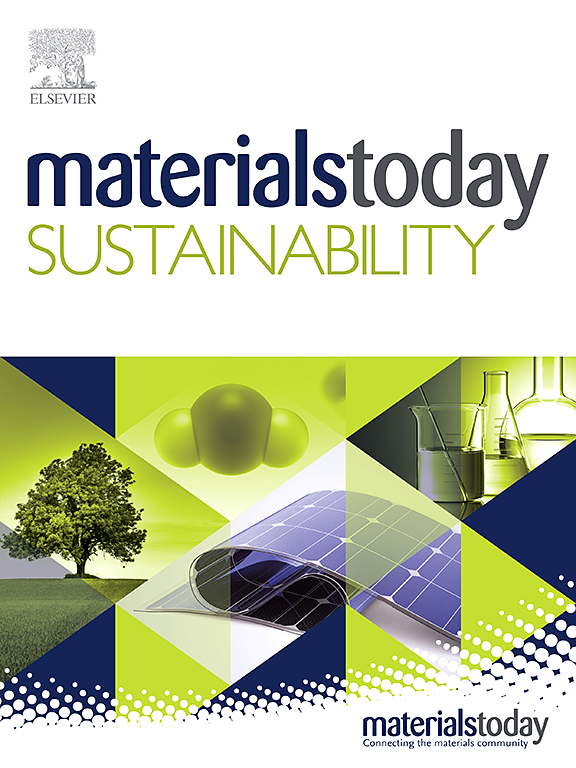Boron/hydrocarbon plasma polymer nanofuels for green energy generation via laser-driven proton-boron fusion
IF 7.1
3区 材料科学
Q1 GREEN & SUSTAINABLE SCIENCE & TECHNOLOGY
引用次数: 0
Abstract
Since 2005, materials rich with hydrogen and boron have been investigated as fuels for laser-driven proton-boron (pB) fusion, which is envisioned as a neutronless alternative to classical fusion for green energy generation. However, laser energy conversion is limited by large energy losses in bulk materials. Highly porous H/B-rich materials may mitigate this issue by enhancing laser absorption, but they are not readily available and are in high demand. Performing plasma polymerization of hexane in a gas aggregation cluster source, we prepared porous, dendrite-structured, micrometer-thick layers of plasma polymerized hydrocarbon nanoparticles of 65 and 560 nm size and optionally overcoated them with sputtered boron. Variable energy positron annihilation spectroscopy and N2 sorption analysis found the multiscale porosity in the resultant nanomaterials, which is given by free volumes in the plasma polymer matrix (with characteristic diameter of 0.4–0.6 nm) and interparticle voids (101–102 nm). NPs were found to retain half the amount of precursor hydrogen, as determined by ERDA. Using the TARANIS laser system (10 J per 800 fs pulse, 2 × 1019 W/cm2), the pB fusion was successfully initiated to produce energetic α-particle fluxes of up to 5.6 x 108 α/sr/shot and 5 × 107 α/sr/J, which is competitive with the best results obtained so far. Our plasma-based method benefits from low amounts of source materials and almost no waste, offering a sustainable route toward hybrid H/B nanofuels with tunable porosity and strong potential for improving the energy conversion efficiency in laser-driven pB fusion.

硼/碳氢等离子体聚合物纳米燃料通过激光驱动质子-硼聚变产生绿色能源
自2005年以来,人们一直在研究富含氢和硼的材料作为激光驱动质子-硼(pB)聚变的燃料,这被设想为一种无中子替代传统聚变的绿色能源发电。然而,由于块状材料的能量损失大,激光能量转换受到限制。高多孔H/ b富材料可以通过增强激光吸收来缓解这一问题,但它们并不容易获得并且需求量很大。在气体聚集簇源中对己烷进行等离子体聚合,制备了65和560nm尺寸的多孔、枝晶结构、微米厚的等离子体聚合碳氢纳米颗粒层,并在其表面选择性地涂上了溅射硼。变能正电子湮没光谱和N2吸附分析发现,所制备的纳米材料具有多尺度孔隙度,由等离子体聚合物基体中的自由体积(特征直径为0.4 ~ 0.6 nm)和粒子间空隙(101 ~ 102 nm)决定。根据ERDA测定,NPs保留了一半的前体氢。利用TARANIS激光系统(10j / 800fs脉冲,2 × 1019 W/cm2),成功地启动了pB聚变,产生了高达5.6 × 108 α/sr/shot和5 × 107 α/sr/J的高能α-粒子通量,与迄今为止获得的最佳结果相媲美。我们基于等离子体的方法的优点是源材料数量少,几乎没有浪费,为混合氢/硼纳米燃料提供了一条可持续的途径,具有可调的孔隙度,并且具有提高激光驱动pB聚变的能量转换效率的强大潜力。
本文章由计算机程序翻译,如有差异,请以英文原文为准。
求助全文
约1分钟内获得全文
求助全文
来源期刊

Materials Today Sustainability
Multiple-
CiteScore
5.80
自引率
6.40%
发文量
174
审稿时长
32 days
期刊介绍:
Materials Today Sustainability is a multi-disciplinary journal covering all aspects of sustainability through materials science.
With a rapidly increasing population with growing demands, materials science has emerged as a critical discipline toward protecting of the environment and ensuring the long term survival of future generations.
 求助内容:
求助内容: 应助结果提醒方式:
应助结果提醒方式:


